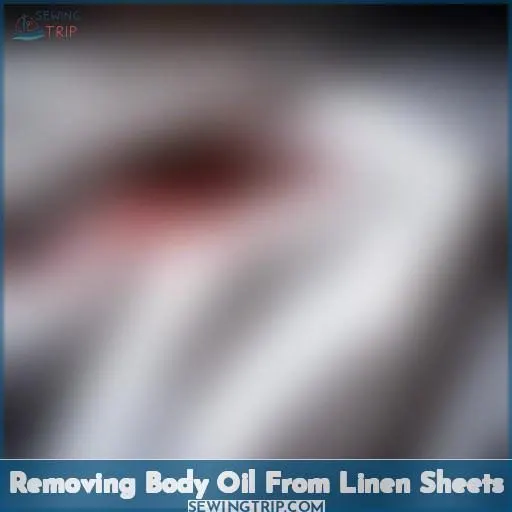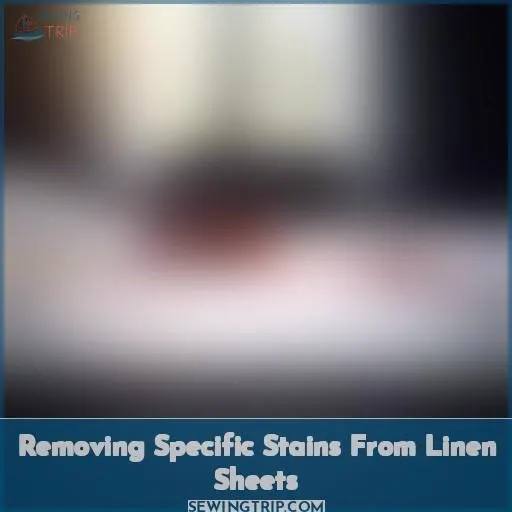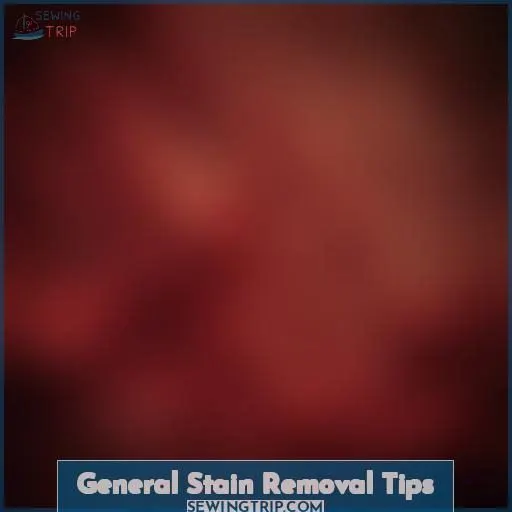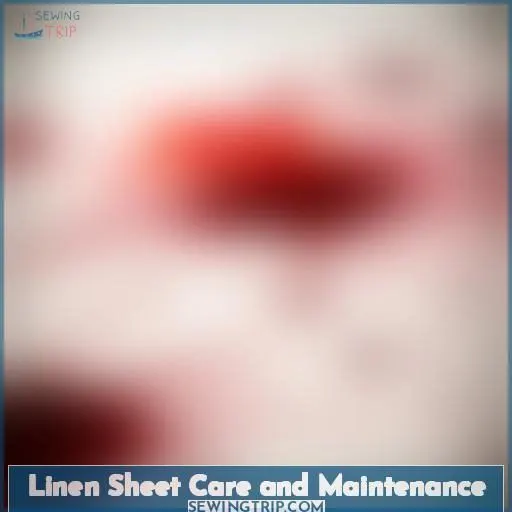This site is supported by our readers. We may earn a commission, at no cost to you, if you purchase through links.
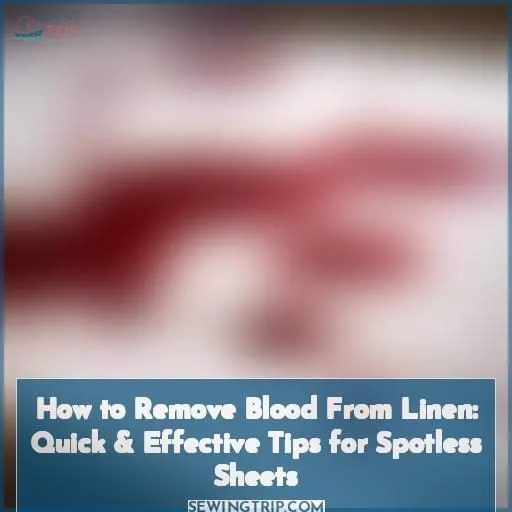 To remove blood from linen sheets, act quickly. First, rinse the stain with cold water to dilute the blood. Then, soak the sheet in cold water for 30 minutes.
To remove blood from linen sheets, act quickly. First, rinse the stain with cold water to dilute the blood. Then, soak the sheet in cold water for 30 minutes.
Next, apply a hydrogen peroxide solution or a paste of salt and water directly to the stain. Wash the sheet in cold water without using fabric softener.
For stubborn stains, use an enzyme-based stain remover. Be sure to test any stain removal techniques on an inconspicuous area first. By following these steps, you can effectively lift blood stains from your linen sheets.
There’s more to know about caring for your linens.
Table Of Contents
Key Takeaways
- Act quickly to treat fresh blood stains by rinsing with cold water and applying hydrogen peroxide or a salt paste before washing.
- For dried blood stains, soak the linen in cold water overnight and apply hydrogen peroxide, then wash regularly and allow to air dry.
- Avoid using hot water and fabric softener when treating blood stains on linen sheets, as they can set the stain and damage the fabric.
- For stubborn stains, consider using an enzyme-based stain remover or oxygen-based bleach, and always test stain removal techniques on an inconspicuous area first.
How to Remove Blood From Linen?
To remove blood stains from linen, follow these steps:
- Rinse the stained area with cold water.
- If the stain persists, make a paste of salt and cold water and apply it to the stain. Let it sit for about 20 minutes, then rinse.
- For stubborn stains, dab hydrogen peroxide (3% solution) on the spot. It works as a mild bleach and is safe for colored linens.
- Machine wash your linen sheets as you normally would, but skip the fabric softener.
Remember to test any stain treatment in an inconspicuous area first to make sure it won’t damage or discolor the fabric.
Removing Blood Stains From Linen Sheets
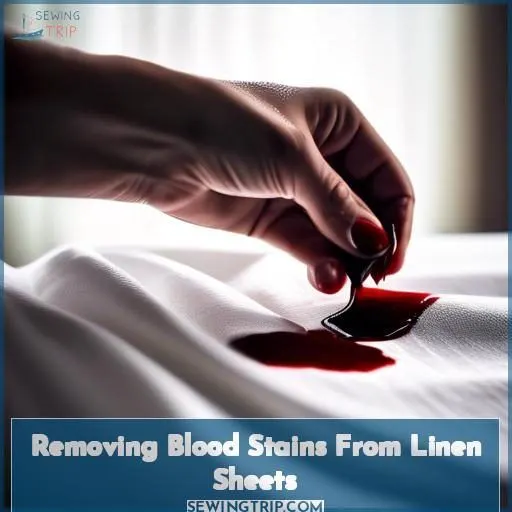
You’ll want to act quickly to remove fresh blood stains from linen sheets, as fresh stains are easier to treat. Soak the stained area in cold water, then apply a stain remover like hydrogen peroxide or salt paste and let it sit for 15-20 minutes before washing in cold water without fabric softener.
Fresh Blood Stains
To remove fresh blood stains from linen sheets, act quickly. Rinse the stain with cold water, dab with a wet cloth, and soak in cold water for 30 minutes. Apply hydrogen peroxide and water, or use laundry detergent. Wash in warm water with bleach, avoiding the dryer until the stain is removed.
Dried Blood Stains
To remove dried blood stains from linen sheets, soak the sheet in cold water overnight. Pour hydrogen peroxide on the stain and use a soft brush to pat it. Machine wash the sheet in a regular cycle and let it dry naturally. For stubborn stains, consider using enzyme-based stain removers or oxygen-based bleach.
Blood Stains on Different Sheet Types
To remove blood stains from different sheet types, use appropriate treatments for each fabric. For cotton sheets, apply a baking soda and water paste. Linen sheets benefit from a vinegar rinse. Bamboo sheets should be soaked in cold water and detergent, while microfiber sheets require gentle detergent and vinegar. If stains persist, consider professional cleaning or special blood stain removers.
Blood Stain Removers
After addressing blood stains on various sheet types, let’s delve into the repertoire of stain removers. From vinegar solutions to stain sticks, these stalwarts work wonders on persistent blood spots.
Treating Blood Stains on Mattresses
To remove blood stains from a mattress, you can use a few simple methods. Here are three effective ways to tackle this issue:
- White Vinegar: Pour a small amount of white vinegar directly onto the stained area and let it sit for about 10 minutes. Blot the area dry with a paper towel or clean cloth, and repeat if necessary. After removing the vinegar, air dry the mattress completely.
- Hydrogen Peroxide: Apply a small amount of 3% hydrogen peroxide to the stained area. The blood stain will foam up on contact with the hydrogen peroxide. Blot the foam away with a cold, wet towel and let the area sit for 15 to 30 minutes. Repeat if needed, and always air dry the mattress.
- Enzyme Cleaner: Use an enzyme-based cleaner specifically designed for upholstery, fabrics, or mattresses. Spray or pour the cleaner onto a towel or rag and blot the stained area. Allow the cleaner to sit for the recommended time, then blot the area with a clean, damp cloth. Use a clean cloth soaked in cold water to rinse the area, then blot dry with a clean, dry cloth. Air dry the mattress.
Remember to always blot the stain with a clean, damp cloth rather than rubbing it into the mattress, as this can damage the fabric. Avoid using hot water or heat, as it can cause the proteins in the blood to bind with the fabric fibers, making the stain more permanent.
Removing Body Oil From Linen Sheets
To remove body oil from linen sheets, you should wash them regularly, ideally once a week or every other week. Before machine washing, apply a baking soda paste by mixing baking soda with water and letting it sit on any oil stains for 15 minutes; this will help lift the oils.
Washing Regularly
To effectively eliminate body oil stains from your linen sheets, it’s imperative to implement a consistent washing routine.
Initially, refrain from employing hot water, as it could exacerbate the oil stain’s adhesion to the fabric.
Conversely, utilize cold water for both washing and rinsing your sheets.
If the stain persists, consider incorporating vinegar into the rinse cycle to aid in the breakdown of the oil.
Moreover, a baking soda paste can be applied to the stain for 15 minutes prior to washing.
Invariably, refer to the care label on your sheets before attempting stain removal, as certain fabrics may necessitate specialized treatments.
Applying Baking Soda Paste
Applying Baking Soda Paste for Stain Removal
When it comes to eliminating stains from linen sheets, baking soda is a versatile and effective solution. Here’s how to utilize it:
Prepare the paste: Combine 1/4 cup of white vinegar with 1/4 cup of baking soda to form a paste. Alternatively, for older stains caused by sweat or body oils, mix equal amounts of hydrogen peroxide and baking soda to create a paste.
Apply the paste: Apply the prepared paste to the stained area and let it rest for at least 15 minutes. For older stains, allow the paste to sit for 30 minutes before laundering.
Wash the linen: After the paste has been effective, launder the linen as usual. This method can effectively eliminate yellow age stains from white linen.
Baking soda is particularly useful for removing body oil stains, as it aids in neutralizing and absorbing the oil. It can also be used to eliminate makeup stains, coffee stains, and even tanning lotion stains. Always remember to test the baking soda paste on a discreet area before applying it to the stain to guarantee that it doesn’t damage the fabric.
Adding Vinegar to Rinse Cycle
Adding vinegar to the rinse cycle is a simple yet effective way to remove body oil from linen sheets. Vinegar benefits include odor removal, stain prevention, and fabric care. A 3×3 table can visually demonstrate the advantages of using vinegar in linen preservation.
Avoiding Hot Water
Avoiding hot water protects your linen sheets from shrinking and fading their vibrant colors. Cold water not only increases linen durability but also mitigates hot water damage, ensuring your sheets remain in excellent condition.
Removing Specific Stains From Linen Sheets
While caring for your linen sheets, you’ll encounter various stains beyond just blood – food, beverages, ink, and makeup can all create stubborn marks.
Act quickly by rinsing and applying the appropriate stain remover or treatment to tackle each type effectively.
For instance, use rubbing alcohol or hand sanitizer on ink stains.
Pre-treat makeup with a gentle dish soap or stain remover.
Food and Beverage Stains
To remove food and beverage stains from linen sheets, follow these steps:
- Blot the stain: Use a clean cloth or paper towel to remove any excess liquid, being careful not to push too hard and transfer dye to the fabric.
- Apply salt: Cover the stain with a generous amount of table salt to absorb the excess liquid.
- Use stain remover: If you have a stain remover, apply it to the stained area and let it sit for a few minutes.
- Soak the stain: Fill a large tub or pan with a solution of lukewarm water mixed with laundry detergent and hydrogen peroxide, or use oxygen bleach, and soak the stained fabric for 15 minutes to an hour.
- Wash as usual: Launder the linen item on a cool cycle with gentle laundry detergent, and air dry to prevent heat from setting the stain.
For specific food and beverage stains, such as coffee or tea, you can use the following methods:
- Coffee stains: Blot the stain with a clean cloth, presoak the stain in a solution of warm water, dishwashing detergent, and white vinegar for 15 minutes, rinse with warm water, and use a sponge and rubbing alcohol to blot up any remaining stain.
- Tea stains: Dab the stain with a cotton bud dipped in bleach, and as soon as the stain disappears, sponge it with plain water.
Remember to act quickly when dealing with food and beverage stains to prevent them from setting into the fabric.
Ink Stains
To remove ink stains from linen sheets, use rubbing alcohol or hand sanitizer. For prevention, avoid using ink pens on your sheets. For color restoration, use fabric care products. DIY solutions include applying a mixture of hydrogen peroxide and dish soap, or using a toothbrush to gently scrub the stain.
Makeup Stains
To remove makeup stains from linen sheets, follow these steps:
- Identify the Stain: Determine if the stain is from an oil-based product like lipstick or a powder product like eyeshadow.
- Prepare the Fabric: Lay the sheet flat on a towel to prevent any potential damage to the fabric.
- Remove Excess Makeup: Gently scrape off any excess makeup with a butter knife or a plastic spoon.
- Treat the Stain: For oil-based stains, use a makeup remover wipe or rubbing alcohol to break down the stain. For powder stains, apply a small amount of liquid laundry detergent directly onto the stain and let it sit for 5-10 minutes.
- Rinse the Fabric: Rinse the back of the fabric thoroughly with cool water until the water runs clear.
- Air Dry: Allow the bedding to fully air dry, then check for any remaining stain.
- Repeat as Needed: If the stain is still visible, repeat the detergent process and gently scrub with a clean toothbrush for any remaining pencil liner stain.
Remember to always test any cleaning solution on an inconspicuous area before applying it to the stain to avoid damaging the fabric.
Stubborn Stains
Stubborn stains on linen sheets can be a challenge to remove, but with the right techniques and products, you can effectively tackle them. Here are some stain remover options and tips for removing stubborn stains from your linen sheets:
- Enzyme Cleaner Uses: Enzyme cleaners, also known as biological detergents, are designed to break down specific categories of stains. They contain enzymes that target different types of stains, such as proteins, starch, pectin, lipids, and sugar. For instance, protease enzymes target protein stains like blood and body fluids, while lipase enzymes work on greasy food stains. Using an enzyme cleaner can be particularly effective for stubborn stains that other cleaning agents may not be able to remove.
- Bleach Alternatives: If you’re looking for a bleach alternative, you can try using hydrogen peroxide. It’s a gentle but powerful oxidizing agent that can help break down stains without damaging the fabric. For blood stains, apply a small amount of hydrogen peroxide directly onto the stain and let it sit for a few minutes before washing the sheet.
- Professional Cleaning Considerations: In some cases, stubborn stains may require professional cleaning. If you’ve tried various stain removal methods and the stain still persists, it might be best to take the sheet to a professional cleaner. They’ve access to specialized equipment and cleaning solutions that can effectively remove even the most difficult stains.
General Stain Removal Tips
When removing stains from linen sheets, it’s essential to respond promptly and utilize the suitable treatment for the stain type. Avoid using hot water and fabric softeners, as these can fix stains. Always test stain removal techniques on an unnoticeable area first to verify they won’t harm the fabric.
Acting Quickly
After addressing specific stains, recall that prompt action is paramount. Here’s your strategy:
- Identify the mishap—time is fleeting!
- Embark on immediate remediation.
- Expeditious response surpasses procrastination.
- Timely intervention prevents stains from solidifying.
Using Appropriate Treatment
To successfully eliminate stains from your linen sheets, it’s essential to employ the appropriate remedies.
For blood stains, utilize cold water, hydrogen peroxide, or salt paste.
To address body oil, apply baking soda paste and vinegar.
For particular stains, utilize stain removers, oxygen-based bleach, or stain sticks.
Always test treatments in an inconspicuous area before applying them to the stain.
Avoiding Hot Water and Fabric Softener
To successfully remove stains from your linen sheets, it’s important to avoid hot water and fabric softener.
Instead, choose cold water and bleach alternatives such as hydrogen peroxide or oxygen-based bleach.
Cold water helps prevent stain setting, while fabric softener can obstruct stain removal methods.
Linen care includes washing without fabric softener and using stain removers or oxygen-based bleach for persistent stains.
Testing Stain Treatment
In the realm of stain removal testing, adhering to certain guidelines is crucial to achieving optimal outcomes and safeguarding your fabrics. Here are some key recommendations:
- Trial in a concealed area: Prior to using any stain removal technique, always conduct a trial on a small, inconspicuous portion of the linen sheet to verify compatibility, avoiding any potential harm or discoloration.
- Select the appropriate method: Choose a stain removal method aligned with the type of stain encountered. For instance, bloodstains may necessitate distinct treatments compared to body oil stains.
- Follow the instructions diligently: Peruse and adhere to the instructions accompanying the stain removal product. This practice will facilitate the best possible results and mitigate any potential fabric damage.
- Employ suitable tools: Certain stain removal methods may necessitate specific tools, such as a gentle brush for removing dried blood stains.
- Consider the fabric type: Different fabrics may demand different stain removal approaches. For example, linen sheets may respond more effectively to certain treatments than cotton sheets.
Linen Sheet Care and Maintenance
If you’re looking for a high-quality linen sheet set that’s built to last, consider the Signature Sheets. With their Oeko-Tex® Standard 100 certification, lifetime warranty, and 101-night sleep trial, you can rest assured you’re investing in sheets that will provide a luxurious and long-lasting sleep experience.
Signature Sheets Set
Upgrade your linen sheet game with the Signature Sheets Set, offering a range of quality options. The set includes a pillowcase, fitted sheet, and flat sheet, all Oeko-Tex® Standard 100 certified for peace of mind. Enjoy a lifetime warranty, 101-night sleep trial, and free shipping and returns.
Oeko-Tex® Standard 100 Certification
After choosing the perfect sheets, it’s reassuring to know that Oeko-Tex certification ensures exceptional sheet quality, fabric safety, and health benefits with minimal environmental impact. Rest easy, indeed!
Lifetime Warranty
Regarding linen sheets, you can rely upon their durability and longevity. With appropriate care, these sheets can endure for many decades, often surpassing cotton or other fabric sheets. Listed below are four crucial facets of the lifetime warranty for your linen sheets:
- Defects in Materials or Craftsmanship: The warranty encompasses any imperfections that may arise in the materials or craftsmanship of your linen sheets.
- Exclusions: The warranty doesn’t cover deterioration, stains, improper usage, inadequate maintenance, modifications by unauthorized representatives, or commercial applications.
- Limited Coverage: The warranty typically endures for a defined period, such as three years from the date of acquisition.
- Replacement Policy: Should your linen sheets demonstrate defects, the manufacturer will, at their own discretion, repair, replace, or reimburse you for them.
101. Night Sleep Trial
To guarantee a restful and immaculate sleep experience, it’s crucial to take appropriate care of your linen sheets. Hale Mercantile Co offers some useful advice for laundering and maintaining your linen bedding. Here are some key aspects to bear in mind:
- Machine Washing: Wash your linen sheets in cold or warm water with a gentle detergent, such as a wool wash. Avoid overloading the machine, as this can cause friction and potential damage to the fabric.
- Drying: Tumble dry your linen sheets on a low to medium heat to preserve their soft textural appeal. Drying at high temperatures can cause the linen fibers to overheat, making them brittle over time.
- Ironing: Although linen sheets can be ironed, it isn’t recommended as they’re designed to be relaxed in nature. If you choose to iron, use a low setting.
- Stain Removal: Address stains promptly by blotting excess liquid, pre-treating with water and mild detergent, and air drying the linen item after stain removal.
- Storage: Store your linen sheets in a cool, dry, well-ventilated place, avoiding plastic bags. Periodically refold your sheets to prevent permanent creases.
Free Shipping and Returns
Enjoy the convenience of free shipping and returns when you purchase linen sheets. With fast and easy returns, you can shop with confidence, knowing that you can easily exchange or return your sheets if needed. Plus, many linen sheet sets come with a lifetime warranty and a 101-night sleep trial, ensuring your satisfaction.
Frequently Asked Questions (FAQs)
What is the best way to remove blood stains from linen sheets?
Treat that crimson culprit on your linen like royalty – a soak in cold water, a dab of hydrogen peroxide, and your sheets will be spotless, fit for a king once more.
How do I remove body oil from linen sheets?
To remove body oil from linen sheets, wash them regularly, apply a baking soda paste for 15 minutes, and add vinegar to the rinse cycle. Avoid hot water, which can set the stain.
Can I use fabric softener when washing linen sheets?
Fabric softener is a big no-no in the context of linen sheets. It can actually degrade the fibers and leave a waxy coating that makes your sheets feel stiff and scratchy. Trust me, your linens will thank you for skipping the softener.
How do I treat specific stains on linen sheets?
To treat specific stains on linen sheets, use the right approach. Blot food and beverage stains with cold water and stain remover. Tackle ink with rubbing alcohol. Pretreat makeup with gentle soap. Oxygen bleach works wonders on stubborn stains.
What is the best way to care for linen sheets?
You’ll be the envy of your friends with these linen sheet care tips! Wash regularly, use baking soda for body oils, and say goodbye to stubborn stains with a dash of vinegar and some good old-fashioned elbow grease.
Conclusion
With proper care, your linen sheets can last for years. In fact, high-quality linens can maintain their soft, luxurious feel for over a decade. Proper linen care is the key to enjoying your sheets for many comfortable nights to come.
Whether it’s a fresh spill or a stubborn dried stain, the right techniques can help you restore your linens to pristine condition. By following the steps outlined in this article, you can effectively remove blood stains from your linen sheets and keep them looking their best.

